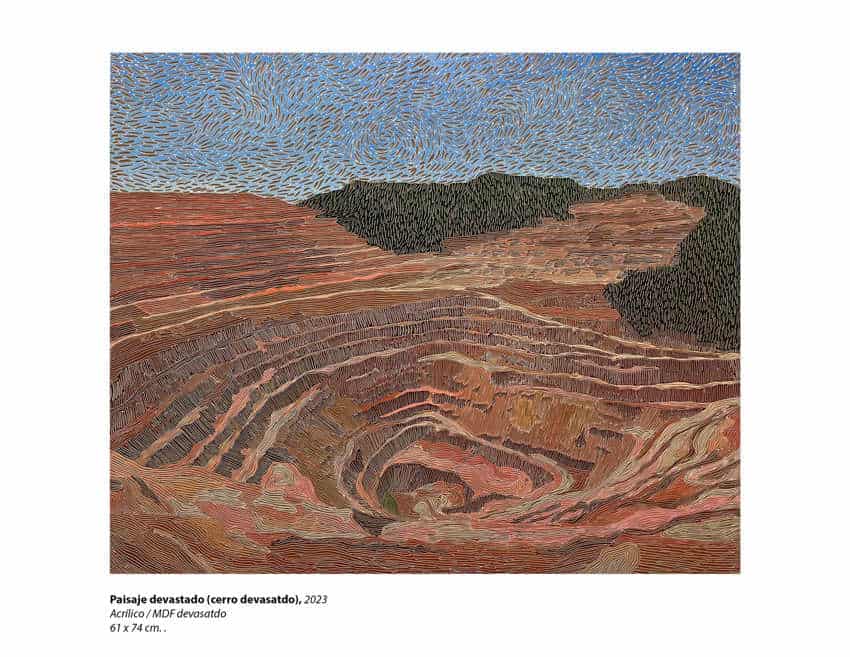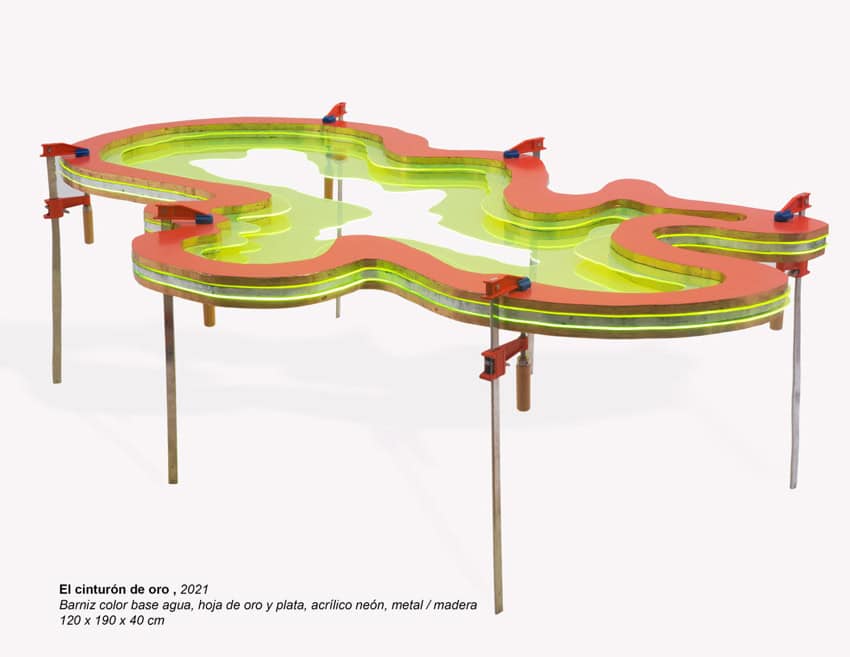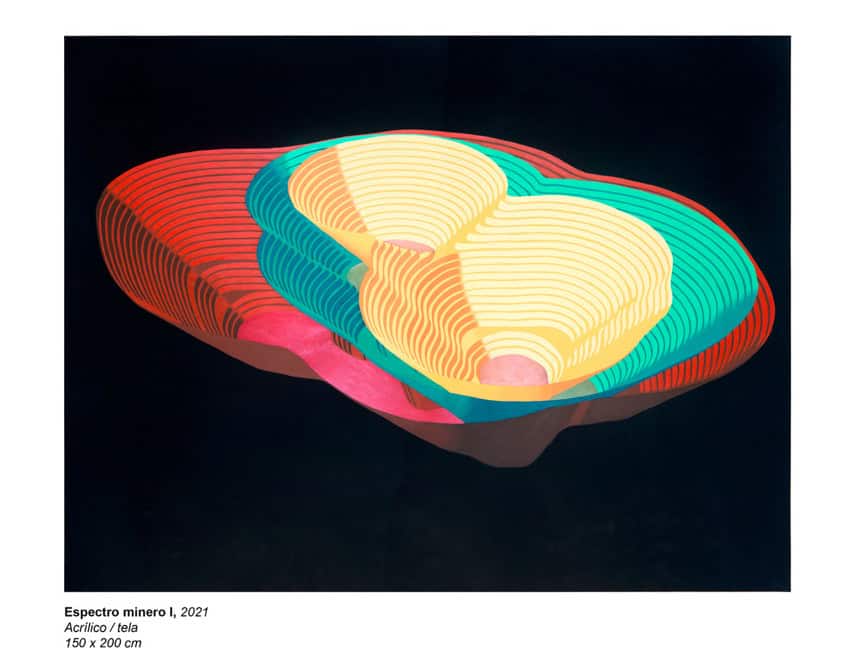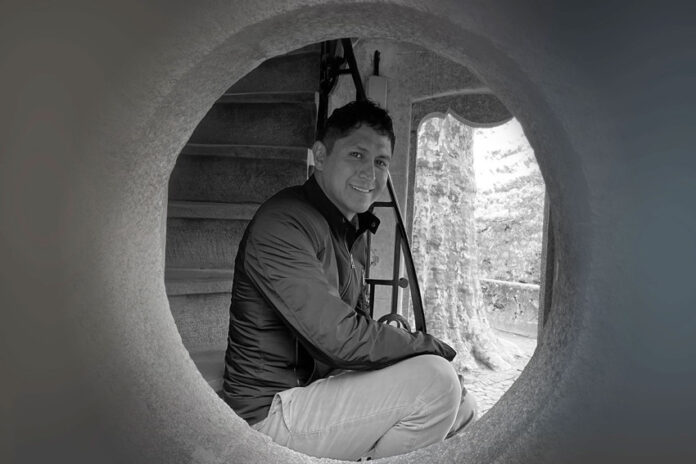The concept of the Anthropocene era — a new geological period coined to document humanity’s impact on Earth — is the subject of recent drawings, paintings and digital graphs by award-winning Mexican visual artist Jaime Colín.
In this series of artworks, Colín, based in Cuernavaca, uses satellite imagery and cartography to produce works that demonstrate the devastation wrought by open-pit mining while creating art of great beauty, a paradox that his fans find both entrancing and thought-provoking.

Colín’s new exhibition, “Geological Spiral: Archives of a Transformed Landscape,” is currently on display at the San Miguel Art Loft in San Miguel de Allende.
Art that documents a transformed landscape
At the exhibition’s opening, gallery owner Debra Broussard discussed how Colín explores the impact upon the land of both natural forces like volcanos and the human-wrought destruction of strip mining.
“While the volcano is a vital pulse of geodynamics,” she noted, “an open-pit mine is a human scar in its most voracious form. Jaime’s body of work does not explicitly seek to condemn or idealize but to explore that point of tension where the landscape reveals its fragility, its power and its capacity for regeneration. To look at these landscapes is to look at the ways we inhabit the Earth, transform it and perhaps repair it.”
Colín further explained that the Anthropocene era has been defined by scientists as beginning in the 1950s, at the time of the first atomic explosions.
“They call it the great acceleration,” he said. “In some of my work, I have compared the craters left by volcanic eruptions with those created by atomic explosions… While I typically cannot know what a viewer takes from my work, I hope to plant seeds, to stimulate dialogue.”

Human contradictions
Much of Colín’s work subtly explores the contradiction between our horror at the environmental degradation of mining and our reliance on the products and modern conveniences that come from it — our complicity. But Colín is quick to clarify that he does not consider himself an activist.
“I’m not an activist, nor am I a journalist,” he said. “Those on the front lines risk their lives — a number of young activists from the communities surrounding open-pit mines in various parts of the country have been killed — while I work safely and comfortably in a studio.”
Exhibition guests expressed their appreciation for the subtlety of Colín’s work.
“Jaime’s art is so beautiful,” said one attendee. “I really love and respect what he’s doing. His sensibility reaches more people, I think, precisely because it’s not so in-your-face.”
Broussard agreed.
“I find it interesting how his work explores this extractive process, but he makes these spirals of the excavations appear beautiful. It’s this wild conflict, perhaps making us uncomfortable — in a good way.”
A childhood spent among mines
Colín’s fascination with the impact of mining on the environment stems from his childhood. Colín grew up in the 1980s in Santa Fe — which is now one of the wealthiest areas of Mexico City — when it was still a village. Open-pit mines were excavated there, and his father worked as a miner. The family lived in simple housing between the mines and huge garbage dumps. With a child’s innocence, he thought it normal to hike through the dump to get to school. He and his siblings even played in the mines.
Eventually, the government resettled the community in another place, with little compensation, only for Santa Fe to be developed into the expensive neighborhood that it is today. Ironically, some of those expensive homes now have to be propped up on stilts because they’re sinking into the landfill ground where Colín once played.

Colín earned a bachelor’s degree in visual arts at the Morelense Center for the Arts and a master’s degree in visual arts and design from the National Autonomous University of Mexico. The two-time winner of competitive federal grants, he has also been invited to exhibit at the Mexico City annual art fair Zona Maco as an emerging artist. He now teaches at the Morelense Center for the Arts.
Viewing the exhibit
Colín’s work may be viewed at the San Miguel Art Loft. To learn more, visit www.sanmiguelartloft.com or contact Debra Broussard at info@sanmiguelartloft.com to schedule a private viewing. The artist may also be contacted directly through his Instagram account @jaisme_colin.
Based in San Miguel de Allende, Ann Marie Jackson is a writer and NGO leader who previously worked for the U.S. Department of State. Her award-winning novel “The Broken Hummingbird,” which is set in San Miguel de Allende, came out in October 2023. Ann Marie can be reached through her website, annmariejacksonauthor.com.
